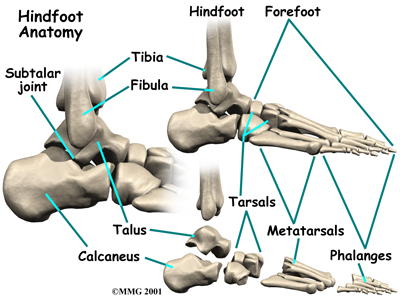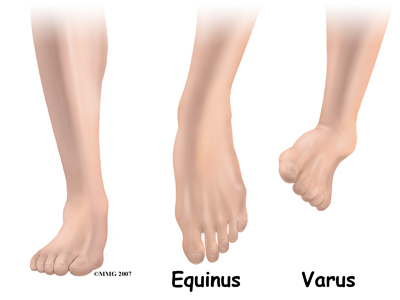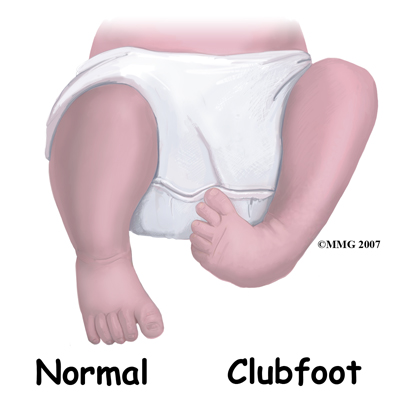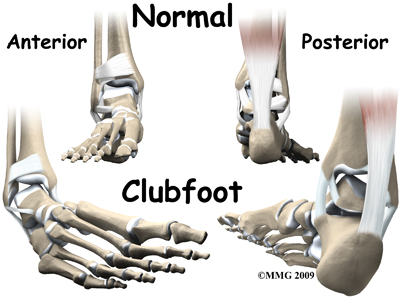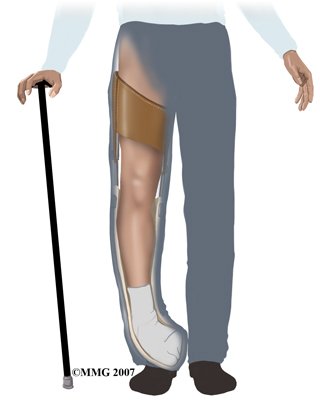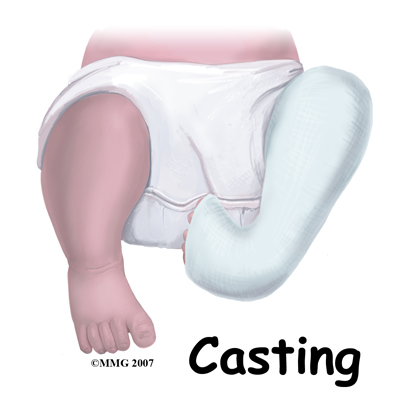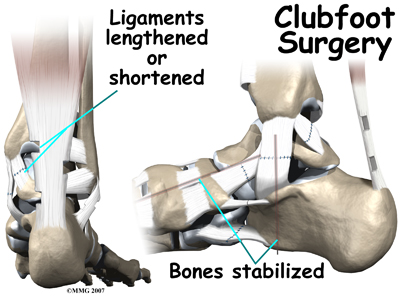What should be expected from treatment?
Physiotherapy at Emerald Hills Physio & Sports Clinic after surgery for a clubfoot can begin as soon as your child’s surgeon recommends it. All treatment, either surgical or non-surgical including physiotherapy, is designed to give the child a foot that can be placed flat on the floor. Another goal of therapy at Emerald Hills Physio & Sports Clinic is to assist your child’s walking biomechanics in order to encourage your child to walk as efficiently as possible. Lastly, our goals also include relieving any pain if present, preventing pain in the future, maintaining the flexibility of your child’s muscles and tissues, and preventing any weaknesses around the lower extremities and core from developing.
During your first appointment at Emerald Hills Physio & Sports Clinic your physiotherapist will discuss your child’s foot brace with you and ensure that you are confident putting it on and taking it off. Your doctor will set the specifications of the brace according to your child’s needs. Your doctor will inform you which activities are safe while in the brace and which ones should be avoided. Your child must learn that he/she can kick and swing the legs simultaneously with the brace on. If your child is still young, your physiotherapist can help you learn how to hold and handle your child with their brace on. If your child is old enough, they should be encouraged to be part of the routine of putting the brace on and taking it off. General bracing advice, such as the best types of socks and clothing garments to wear with the brace as well as proper strapping or lacing of the brace will also be discussed.
Your physiotherapist will also inspect your child’s bare feet and note any areas of the brace that may be irritating your child. Generally your child will need to build up a tolerance to wearing the brace and for this reason some areas where pressure is noted by redness may be considered normal. Any areas of redness, however, should be closely monitored and padded for extra comfort and to disperse the pressure if necessary.
Creams or lotions should not be applied to areas where the skin is red (and unbroken) as this can make the friction worse. Areas that have developed blisters will need to be protected to avoid them getting worse or breaking open. Any broken or fragile skin can become a more serious problem and prevent the braces from being worn for a prolonged period of time, which can result in a relapse of the clubfoot position. In some cases a return visit to your doctor or Orthotist for an early adjustment of the brace may be necessary.
The schedule of how long your child will have to wear the brace each day will be set by your child’s surgeon. At first the time with the brace on will likely need to be most of the day and night. Generally the wearing time is gradually decreased over time so that your child has some awake time without the brace on. In most cases children will need to wear the brace during all sleep times until eventually sleep time is the only time the child is required to wear the brace. Depending on the age of your child, once the brace is discarded during the day, your physiotherapist may incorporate taping techniques of the foot to provide gentle foot positioning guidance.
Your physiotherapist may address any pain issues that your child may be experiencing from the surgical procedure or the deformity itself, depending on the age of your child. Your physiotherapist may use modalities such as ice, heat or massage to try to relieve any pain. In some cases they may even use ultrasound, again depending on your child’s age and the location of their pain.
Maintaining the length of the tissues in your child’s foot is the main goal of any stretching exercises we do with your child or ask you to do with them. Your child’s age at the time of surgery will largely influence how formal the stretches and strengthening exercises for your child will be. If they are old enough to understand and follow along, your physiotherapist may encourage specific stretches for the back of the calf and Achilles tendon, as well as for the bottom of the foot. Often, however, children who have had surgery for clubfoot are too young to effectively engage in formal stretches therefore play activities that encourage these types of stretches will be taught. Ensuring that your child spends time squatting, standing with feet flat, standing on their toes, standing on their heels, walking without the brace, and practicing jumping are ways to encourage proper foot movement. Your physiotherapist will guide you through which of the activities are most important for your child at which time, the proper technique for these activities, and how long they should be performing each activity. While at Emerald Hills Physio & Sports Clinic you will be taught by your therapist how to apply pressure properly to your child’s foot or leg during these activities in order to encourage normal foot alignment. If your child is too young to walk or do the higher level activities then your physiotherapist will teach you age-appropriate play activities that encourage the proper positioning of your child’s foot and lower leg. Range of movement exercises that encourage motion of the foot in all directions away from the clubfoot position will be important. Of particular importance are passive Achilles tendon stretches, which will be taught to you and will be encouraged frequently. The Achilles tendon is the thick tendon at the back of the ankle.
Maintaining the length of the Achilles tendon after casting and surgery to lengthen it prepares the foot and ankle to take the body’s weight for activities such as walking, squatting, and jumping. It should be noted how important it is to maximize use of the time that your child spends outside of the brace by doing the specified activities that your physiotherapist prescribes as this will train the muscles to hold your child’s new foot position and give the other tissues as much active stretching as possible.
Formal strengthening exercises for older children will be taught which encourage ankle, calf, hip, and core strengthening as well strengthening for the muscles that pull the foot into a position where the sole of the foot is turned up and out (opposite to the clubbed foot position.) As previously mentioned often the child who has had surgery for clubfeet is too young to perform any formal exercises. Playing is once again the best method to encourage strength development in your child’s feet, legs and core area.
Your physiotherapist will encourage fun play activities and games such as assisted frog jumps or hops on one leg in order to strengthen the appropriate muscles. Even helping the young child mimic these types of activities can be very useful to strengthen the legs and feet and encourage proper foot position. Any activity they enjoy which encourages the proper motion is useful! Often singing while doing activities or making a game of the exercises is the best method of incorporating rehabilitation into your young child’s world.
For those children that are old enough to ambulate, gait retraining when the brace is off is a crucial part of our rehabilitation at Emerald Hills Physio & Sports Clinic after surgery for clubfeet. By using hands on techniques your therapist will encourage the appropriate motions for your child while they walk and they will teach you how to do the same for when you do the exercises at home. Your physiotherapist will also work on your child’s foot and ankle proprioception (knowing where their foot is in space without them having to look at it) by having them stand or walk on different surfaces such as a soft mat or foam, as well as on different angles. Activities such as hopping or climbing on apparatus will also help to improve their proprioception. Climbing up onto things such as stairs or gym equipment simultaneously helps to build the needed strength in the hip area, which is an important area that assists in controlling the knee and foot position. For children who are not yet walking, holding them in the standing position (with proper foot alignment) on different surfaces as well as on different angles will accomplish the same thing. Most importantly, for all exercises, the goal is to get the foot into a proper weight bearing position and keep it out of the clubbed foot position.
Your therapist will be a useful resource for discussing footwear modifications for your child if needed. They may consult with a Podiatrist to ensure that the most appropriate footwear is prescribed for you child.
As your child grows, rehabilitation will need to be continued but the frequency of sessions should decrease as long as early intervention has started your child on the right path to correcting the alignment of your child’s foot, ankle, and lower limb, and as long as you are actively doing the home rehabilitation program. As your child grows and becomes more mature, physiotherapy at Emerald Hills Physio & Sports Clinic will include more formal types of exercises to encourage proper foot alignment. It is expected that your child will eventually be able to partake in all physical activities that other children their age partake in.
Generally children who have had surgery for clubfeet do extremely well with the physiotherapy we provide at Emerald Hills Physio & Sports Clinic. Over the course of your child’s therapy your therapist will liaise closely with your child’s doctor, surgeon, Orthotist, and Podiatrist as well as any other health care professionals that are involved in their care to ensure your child is recovering as quickly and normally as possible.
Emerald Hills Physio & Sports Clinic provides services for physiotherapy in Sherwood Park.
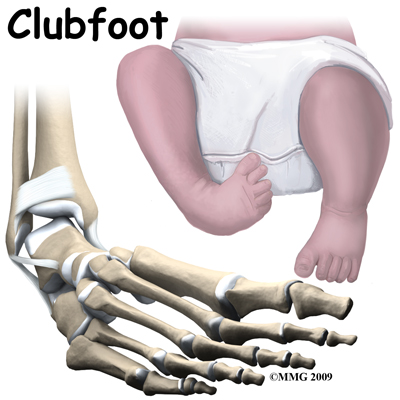 Clubfoot is a congenital condition that affects newborn infants. The medical term for clubfoot is Congenital Talipes Equinovarus. This condition has been described in medical literature since the ancient Egyptians. Congenital means that the condition is present at birth and occurred during fetal development. The condition is not rare and the incidence varies widely among different races. In the Caucasian population, about one in a thousand infants are born with a clubfoot. In Japan, the numbers are one in two thousand and in some races in the South Pacific it can be as high as seven infants in one thousand who are born with a clubfoot. The condition affects both feet in about half of the infants born with clubfoot. Clubfoot affects twice as many males as females.
Clubfoot is a congenital condition that affects newborn infants. The medical term for clubfoot is Congenital Talipes Equinovarus. This condition has been described in medical literature since the ancient Egyptians. Congenital means that the condition is present at birth and occurred during fetal development. The condition is not rare and the incidence varies widely among different races. In the Caucasian population, about one in a thousand infants are born with a clubfoot. In Japan, the numbers are one in two thousand and in some races in the South Pacific it can be as high as seven infants in one thousand who are born with a clubfoot. The condition affects both feet in about half of the infants born with clubfoot. Clubfoot affects twice as many males as females.
